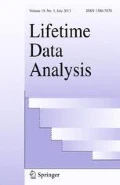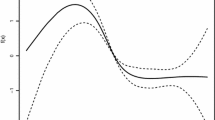Abstract
A marginal regression approach for correlated censored survival data has become a widely used statistical method. Examples of this approach in survival analysis include from the early work by Wei et al. (J Am Stat Assoc 84:1065–1073, 1989) to more recent work by Spiekerman and Lin (J Am Stat Assoc 93:1164–1175, 1998). This approach is particularly useful if a covariate’s population average effect is of primary interest and the correlation structure is not of interest or cannot be appropriately specified due to lack of sufficient information. In this paper, we consider a semiparametric marginal proportional hazard mixture cure model for clustered survival data with a surviving or “cure” fraction. Unlike the clustered data in previous work, the latent binary cure statuses of patients in one cluster tend to be correlated in addition to the possible correlated failure times among the patients in the cluster who are not cured. The complexity of specifying appropriate correlation structures for the data becomes even worse if the potential correlation between cure statuses and the failure times in the cluster has to be considered, and thus a marginal regression approach is particularly attractive. We formulate a semiparametric marginal proportional hazards mixture cure model. Estimates are obtained using an EM algorithm and expressions for the variance–covariance are derived using sandwich estimators. Simulation studies are conducted to assess finite sample properties of the proposed model. The marginal model is applied to a multi-institutional study of local recurrences of tonsil cancer patients who received radiation therapy. It reveals new findings that are not available from previous analyses of this study that ignored the potential correlation between patients within the same institution.
Similar content being viewed by others
References
Chandler RE and Bate S (2007). Inference for clustered data using the independence loglikelihood. Biometrika 94: 167–183
Chatterjee N and Shih J (2001). A bivariate cure-mixture approach for modeling familial association in disease. Biometrics 57: 779–786
Chen M-H, Ibrahim JG and Sinha D (2002). Bayesian inference for multivariate survival data with a cure fraction. J Multivariate Anal 80: 101–126
Clayton DG (1978). A model for association in bivariate life tables and its application in epidemiological studies of familial tendency in chronic disease incidence. Biometrika 65: 141–152
Cox DR (1972). Regression models and life-tables. J Roy Statis Soc Ser B 34: 187–220
Fang H-B, Li G and Sun J (2005). Maximum likelihood estimation in a semiparametric logistic/proportional-hazards mixture model. Scand J Stat 32: 59–75
Kalbfleisch JD and Prentice RL (2002). The statistical analysis of failure time data, 2nd edn. Wiley, New York
Kuk AYC and Chen C (1992). A mixture model combining logistic regression with proportional hazards regression. Biometrika 79: 531–41
Lee AJ (1993). Generating random binary deviates having fixed marginal distributions and specified degree of association. Am Stat 47: 209–215
Li C-S and Taylor JMG (2002). A semi-parametric accelerated failure time cure model. Statis Med 21: 3235–3247
Liang K-Y and Zeger SL (1986). Longitudinal data analysis using generalized linear models. Biometrika 73: 13–22
Lin DY (1994). Cox regression analysis of multivariate failure time data: the marginal approach. Stat Medi 13: 2233–2247
Lipsitz SR, Dear KBG and Zhao L (1994). Jackknife estimators of variance for parameter estimates from estimating equations with applications to clustered survival data. Biometrics 50: 842–846
Lipsitz SR and Parzen M (1996). A jackknife estimator of variance for Cox regression for correlated survival data. Biometrics 52: 291–298
McLachlan G and Peel D (2000). Finite mixture models. Wiley, New York
Oakes D (1999). Direct calculation of the information matrix via the EM algorithm. J Roy Stat Soc, Ser B, 61: 479–482
Park CG, Park T and Shin DW (1996). A simple method for generating correlated binary variates. Am Stat 50: 306–310
Peng Y (2003). Fitting semiparametric cure models. Comput Stat Data Anal 41: 481–490
Peng Y and Dear KBG (2000). A nonparametric mixture model for cure rate estimation. Biometrics 56: 237–243
Peng Y, Dear KBG and Denham JW (1998). A generalized F mixture model for cure rate estimation. Stat Med 17: 813–830
Royall RM (1986). Model robust confidence intervals using maximum likelihood estimators. Int Stat Rev 54: 221–226
Spiekerman CF and Lin DY (1998). Marginal regression models for multivariate failure time data. J Am Stat Assoc 93: 1164–1175
Sy JP and Taylor JMG (2000). Estimation in a Cox proportional hazards cure model. Biometrics 56: 227–236
Tsodikov AD, Ibrahim JG and Yakovlev AY (2003). Estimating cure rates from survival data: an alternative to two-component mixture models. J Am Stat Assoc 98: 1063–1078
Wei LJ, Lin DY and Weissfeld L (1989). Regression analysis of multivariate incomplete failure time data by modeling marginal distributions. J Am Stat Assoc 84: 1065–1073
Wienke A, Lichtenstein P and Yashin AI (2003). A bivariate frailty model with a cure fraction for modeling familial correlation in disease. Biometrics 59: 1178–1183
Withers HR, Peters LJ, Taylor JMG, Owen JB, Morrison WH, Schultheiss TE, Keane T, O’Sullivan B, Gupta N, Wang CC, Jones CU, Doppke KP, Myint S, Thompson M, Parsons JT, Mendenhall WM, Dische S, Aird EGA, Henk JM, Bidmean MAM, Svoboda V, Chon Y, Hanlon AL, Peters TL, Hanks GE and Dyk J (1995). Local control of carcinoma of the tonsil by radiation therapy: an analysis of patterns of fractionation in nine institutions. Int J Radiat Oncol, Biol, Phys 33: 549–562
Yamaguchi K (1992). Accelerated failure-time regression models with a regression model of surviving fraction: an application to the analysis of ‘permanent employment’ in Japan. J Am Stat Assoc 87: 284–292
Yau KKW and Ng ASK (2001). Long-term survivor mixture model with random effects: application to a multi-centre clinical trial of carcinoma. Stat Med 20: 1591–1607
Author information
Authors and Affiliations
Corresponding author
Rights and permissions
About this article
Cite this article
Peng, Y., Taylor, J.M.G. & Yu, B. A marginal regression model for multivariate failure time data with a surviving fraction. Lifetime Data Anal 13, 351–369 (2007). https://doi.org/10.1007/s10985-007-9042-4
Received:
Accepted:
Published:
Issue Date:
DOI: https://doi.org/10.1007/s10985-007-9042-4




